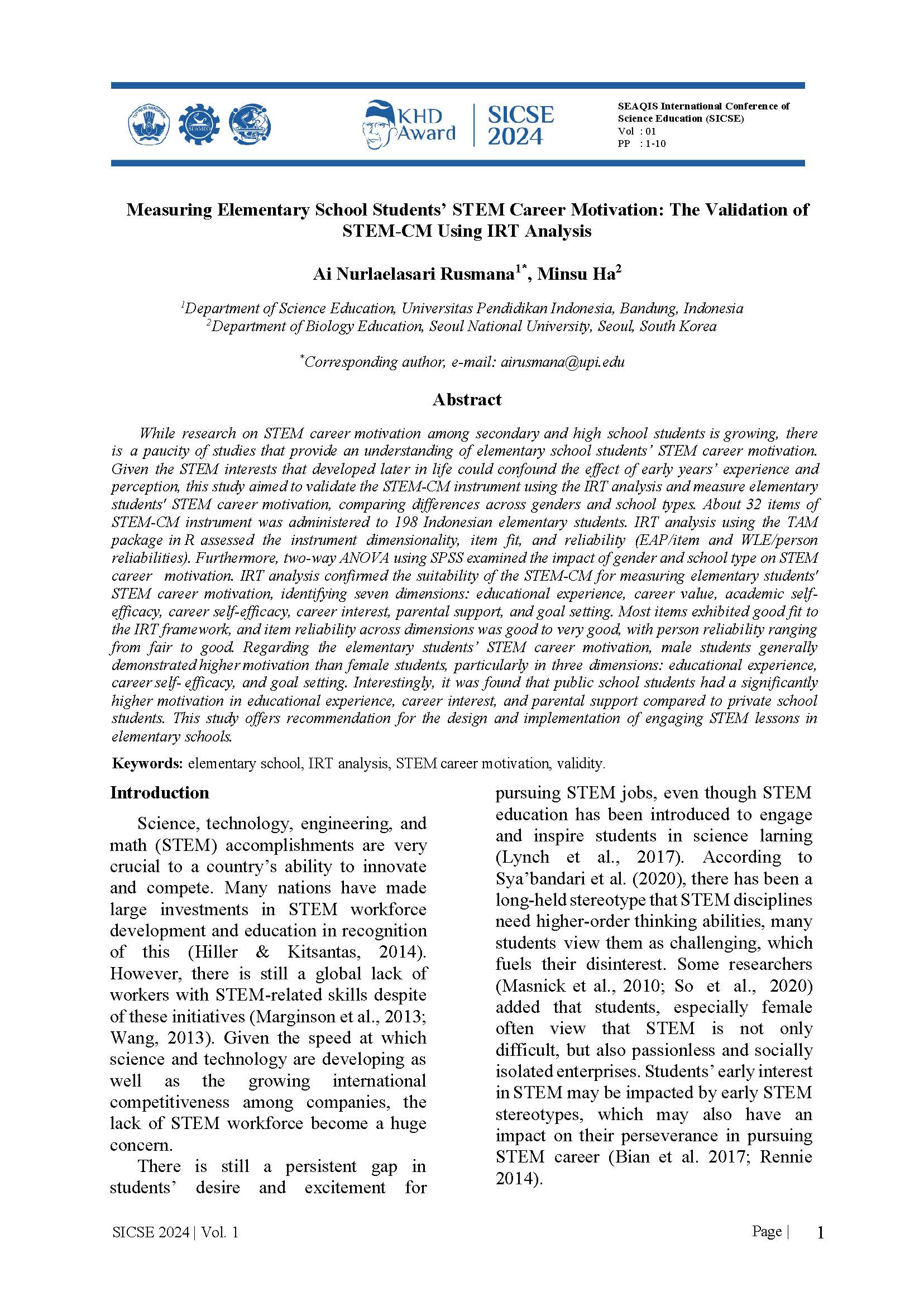Measuring Elementary School Students’ STEM Career Motivation: The Validation of STEM-CM Using IRT Analysis
DOI:
https://doi.org/10.58249/jhp99t46Keywords:
elementary school, IRT analysis, STEM career motivation, validityAbstract
While research on STEM career motivation among secondary and high school students is growing, there is a paucity of studies that provide an understanding the elementary school students’ STEM career motivation. Given the STEM interests that developed later in life would confound the effect of early years’ experience and perception, this study aimed to validate the STEM-CM instrument using the IRT analysis and measure elementary students' STEM career motivation, comparing differences between genders and school type. About 32 items of STEM-CM instrument was administered to 198 Indonesian elementary students. IRT analysis using the TAM package in R assessed the instrument dimensionality, item fit, and reliability (EAP/item and WLE/person reliabilities). Furthermore, two-way ANOVA using SPSS examined the impact of gender and school type on STEM career motivation. IRT analysis confirmed the suitability of the STEM-CM for measuring elementary students' STEM career motivation, identifying seven dimensions: educational experience, career value, academic self-efficacy, career self-efficacy, career interest, parental support, and goal setting. Most items exhibited good fit to the IRT framework, and item reliability across dimensions was good to very good, with person reliability ranging from fair to good. Regarding the elementary students’ STEM career motivation, male students generally demonstrated higher motivation than female students, particularly in three dimensions: educational experience, career self-efficacy, and goal setting. Interestingly, it was found that public school students had a significantly higher motivation in educational experience, career interest, and parental support compared to private school students. This study offers recommendation for the design and implementation of engaging STEM lessons in elementary schools.
References
Bond, T., & Fox, C. M. (2015). Applying the Rasch model: Fundamental measurement in the human sciences. New York: Routledge.
Chiu, T. K., Ismailov, M., Zhou, X., Xia, Q., Au, C. K., & Chai, C. S. (2023). Using self- determination theory to explain how community-based learning fosters student interest and identity in integrated STEM education. International Journal of Science and Mathematics Education, 21(Suppl 1), 109-130.
Cohen, J. (1969). Statistical power analysis for the behavioral sciences. New York: Academic Press.
Cwik, S., & Singh, C. (2021). Damage caused by societal stereotypes: Women have lower physics self-efficacy controlling for grade even in courses in which they outnumber men. Physical Review Physics Education Research, 17(2), 020138.
Dasgupta, N., & Stout, J. G. (2014). Girls and women in science, technology, engineering, and mathematics: STEMing the tide and broadening participation in STEM careers. Policy Insights from the Behavioral and Brain Sciences, 1(1), 21–29.
Fisher, C. R., Thompson, C. D., & Brookes, R. H. (2020). Gender differences in the Australian undergraduate STEM student experience: A systematic review. Higher Education Research & Development, 39(6), 1155–1168.
Fisher, W. P. Jr (2007). Rasch measurement transaction. Transaction of the Rasch Measurement SIG American Educational Research Association, 21(1), 1095.
Holmes, K., Gore, J., Smith, M., & Lloyd, A. (2018). An integrated analysis of school students’ aspirations for STEM careers: Which student and school factors are most predictive? International Journal of Science and Mathematics Education, 16(4), 655–675.
Kinkopf, D., & Dack, H. (2023). Teachers’ perceptions of increasing STEM self-efficacy among female middle grades students. RMLE Online, 46(5), 1-21.
Moss-Racusin, C. A., Sanzari, C., Caluori, N., & Rabasco, H. (2018). Gender bias produces gender gaps in STEM engagement. Sex Roles, 79(11–12), 651–670.
Neumann, I., Neumann, K., & Nehm, R. (2011). Evaluating instrument quality in science education: Rasch-based analyses of a nature of science test. International Journal of Science Education, 33(10), 1373–1405.
Nugent, G., Barker, B., Welch, G., Grandgenett, N., Wu, C., & Nelson, C. (2015). A model of factors contributing to STEM learning and career orientation. International Journal of Science Education, 37(7), 1067–1088.
Robnett, R. D. (2016). Gender bias in STEM fields: Variation in prevalence and links to stem self-concept. Psychology of Women Quarterly, 40(1), 65–79.
Sadler, P. M., Sonnert, G., Hazari, Z., & Tai, R. (2012). Stability and volatility of STEM career interest in high school: A gender study. Science Education, 96(3), 411–427.
Shin, S., Ha, M., & Lee, J. K. (2016). The development and validation of instrument for measuring high school students’ STEM career motivation. Journal of the Korean Association for Science Education, 37(1), 75–86.
Shin, S., Rachmatullah, A., Roshayanti, F., Ha, M., & Lee, J. K. (2018). Career motivation of secondary students in STEM: a cross-cultural study between Korea and Indonesia. International Journal for Educational and Vocational Guidance, 18, 203-231.
Skamp, K. (2007). Conceptual learning in the primary and middle years: The interplay of heads, hearts, and hands-on science. Teaching Science, 53(3), 18–22.
Sulistyosari, Y., Wardana, A., & Dwiningrum, S. I. A. (2023). School zoning and equal education access in Indonesia. International Journal of Evaluation and Research in Education (IJERE), 12(2), 586 - 593.
Sukmayadi, V., & Yahya, A. (2020). Indonesian education landscape and the 21st century challenges. Journal of Social Studies Education Research, 11(4), 219-234.
Sya’bandari, Y., Aini, R. Q., Rusmana, A. N., & Ha, M. (2021, July). Indonesian students’ STEM career motivation: A study focused on gender and academic level. In Journal of Physics: Conference Series (Vol. 1957, No. 1, p. 012029). IOP Publishing.
Tai, R. H., Liu, C. Q., Maltese, A. V., & Fan, X. (2006). Planning early for careers in science. Science, 312(5777), 1143–1144.
Wang, N., Tan, A. L., Zhou, X., Liu, K., Zeng, F., & Xiang, J. (2023). Gender differences in high school students’ interest in STEM careers: A multi-group comparison based on structural equation model. International Journal of STEM Education, 10(1), 59.
Wright, B. D., & Linacre, J. M. (1994). Reasonable mean-square fit values. Rasch Measurement Transactions, 8(3), 370.
Zachmann, K. (2018). Women in STEM: Female role models and gender equitable teaching strategies. Graduate research, ST. Catherine University

Downloads
Published
Issue
Section
License
Copyright (c) 2025 SEAQIS International Conference on Science Education

This work is licensed under a Creative Commons Attribution 4.0 International License.
This work is licensed under a Creative Commons Attribution 4.0 International License.

